(T2108 measures the percentage of stocks trading above their respective 40-day moving averages [DMAs]. It helps to identify extremes in market sentiment that are likely to reverse. To learn more about it, see my T2108 Resource Page. You can follow real-time T2108 commentary on twitter using the #T2108 hashtag. T2108-related trades and other trades are occasionally posted on twitter using the #120trade hashtag. T2107 measures the percentage of stocks trading above their respective 200DMAs)
T2108 Status: 28.7%
T2107 Status: 35.2%
VIX Status: 13.4
General (Short-term) Trading Call: Neutral
Active T2108 periods: Day #192 over 20% (overperiod), Day #3 under 30%, Day #7 under 40%, Day #47 under 50%, Day #64 under 60%, Day #263 under 70%
Reference Charts (click for view of last 6 months from Stockcharts.com):
S&P 500 or SPY
SDS (ProShares UltraShort S&P500)
U.S. Dollar Index (volatility index)
EEM (iShares MSCI Emerging Markets)
VIX (volatility index)
VXX (iPath S&P 500 VIX Short-Term Futures ETN)
EWG (iShares MSCI Germany Index Fund)
CAT (Caterpillar).
Commentary
The market simply could not wait for the U.S. Federal Reserve to give its usual “all clear” signal this time around.
The Fed announces its next monetary decision tomorrow (Wednesday, July 29). The market looked like it was headed into true oversold conditions just in time to let the Fed work its powers of soothing. In the T2108 Update for last Friday, I laid out all the bearish signs that had converged as T2108 hovered above oversold conditions. I was hoping that the S&P 500 (SPY) would retest support at its 200-day moving average (DMA) just as T2108 broke below 20% (oversold): such a combination would trigger my rules to aggressively buy the index. Instead, the index PERFECTLY retested its 200DMA (you can’t make this stuff up!) while T2108 stubbornly got only as low as 24%. T2108 did not even crack the low from the previous cycle of fear.
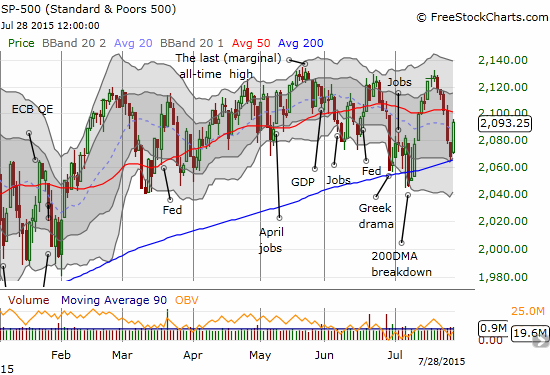
Although my ideal trading conditions did not trigger, I was still prepared to benefit from a bounce because the volatility index, the VIX, triggered the related “fade volatility” trade. On Monday, the VIX traded above the 15.35 pivot. With T2108 “close enough” to oversold (meaning it is below 30%), I nibbled on some put options on ProShares Ultra VIX Short-Term Futures (UVXY).
%stocks>40DMA was 24.8% at lows today. #VIX struggling around 15.35 pivot. $UVXY fades. #120trade #T2108 S&P 500 bounce off 200DMA $SPY
— Duru A (@DrDuru) Jul. 27 at 07:53 AM
I had expected to accumulate MORE puts on UVXY ahead of the Fed. Instead, I ended up taking profits as the volatility index plunged well below the 15.35 pivot.
%stocks>40DMA was 24.8% at lows today. #VIX struggling around 15.35 pivot. $UVXY fades. #120trade #T2108 S&P 500 bounce off 200DMA $SPY
— Duru A (@DrDuru) Jul. 27 at 07:53 AM
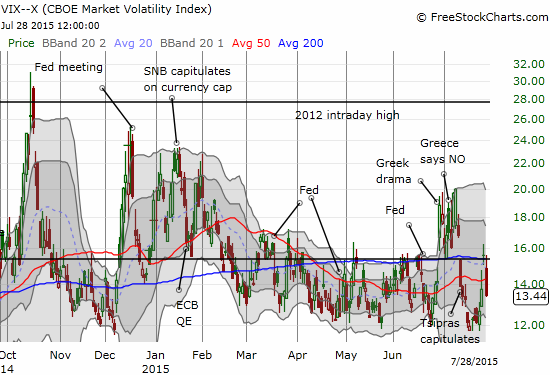
The Australian dollar added confirmation that the market hit an important turn-around as it held steady against the Japanese yen. On Monday, AUD/JPY approached the previous low but did not break it.
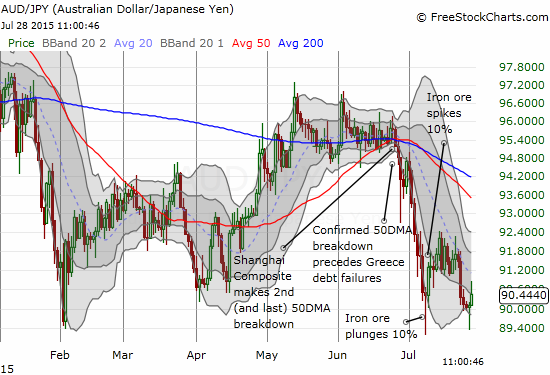
Despite all these positive signs of a turn-around, I am definitely NOT giving the “all clear” signal just yet. The bearish signals that led to this latest encounter with oversold conditions are not yet invalidated. For starters, the S&P 500 needs to at least close above its 50DMA; even better, it needs a new all-time high. AUD/JPY needs to clear recent congestion (say over 92.4) rather than get turned back like a brick wall. T2107, the percentage of stocks trading above their 200DMAs, rallied today with the market but this longer-term signal remains BELOW the low of the last cycle of fear. I will be monitoring all these signals including the VIX.
I am NOT using the Shanghai Composite Index (SSEC) as a market signal, but I AM intrigued to see how well the market rallied even as SSEC gapped down to start trading in China and closed with another loss on the day. The Chinese government is clearly still watching the technicals closely. The gap down was stopped cold right at 200DMA support. THIS stuff you CAN make up – at least the Chinese government can!
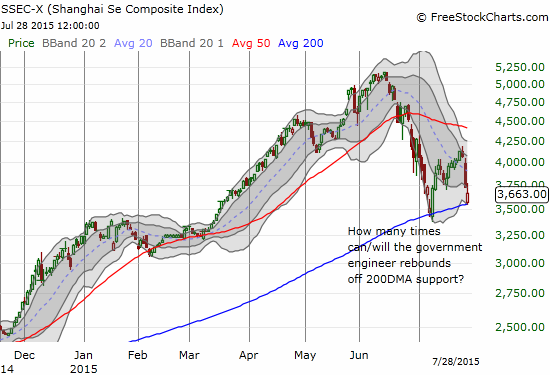
In other important/interesting trading action, I have Caterpillar (CAT), Grub Hub (GRUB), and Apple (AAPL).
As regular readers know, CAT is my favorite hedge against market bullishness. Today, however, it turned into my favorite play on oversold conditions. My trading mentor has created a fantastic stock scan website called SwingTradeBot. On Monday, one particular scan caught my eye:
Scan results – Gilligan’s Island Buy Setup today: $ROP $MTW $CAT $LXK $ALSN $FLS $STT $ZBRA $GLOG $H … http://t.co/INpmn4B5HC
— SwingTradeBot (@SwingTradeBot) July 27, 2015
There was CAT! After seeing the stock had closed four days in a row below its lower-Bollinger Band (BB), including a post-earnings gap down, I immediately put the stock on my buy list. This kind of selling pressure leads to oversold conditions and few stocks can sustain positioning beyond the BBs for long. Monday’s doji, aka a small body, is another classic bottoming sign that shows that buyers and sellers fought to a stalemate.
The term “Gilligan’s Island Buy Setup” is a bit silly and not intuitive. Here is the definition from a concept called “hit-and-run trading” from the book Hit & Run Trading: The Short-Term Stock Traders Bible. Copied from the SwingTradeBot site…
- A stock must gap open to a new two-month low. The bigger the gap the better.
- The stock must close at or in the bottom 50 percent of its daily range and equal to or above the opening.
- For the buy: The next day only, buy 1/8 point above today’s high.
- Risk 1 point.
- Carry the position overnight if it closes strongly.
CAT easily met the first two conditions with Monday’s close. Tuesday’s open met the third condition. Risking just over a point would break to a fresh multi-year low, so the fourth condition was easy. Given the strong open, and the high odds that an oversold bounce was underway, I loaded up aggressively on call options. I was prepared to hold until the close to test the last condition. Much to my surprise, in less than an hour, my position had already doubled in value, and CAT was up around 2.5%. Under THOSE conditions, I had to take the profit off the table in extreme gratitude. If I had waited for the last condition, I would have seen the position growth almost 4x as CAT closed up 3.3%.
The buying volume and trading action was SO strong that CAT effectively left behind an abandoned baby bottom. This pattern traps bears who chased the last gap down only to find themselves in an instant loss on a gap up the next day. The CAT bears are now under pressure to close and run. This pattern alone makes me more optimistic for the market in the short-term. THIS could potentially be the most important turn-around of all the turns I have shown in this T2108 Update.
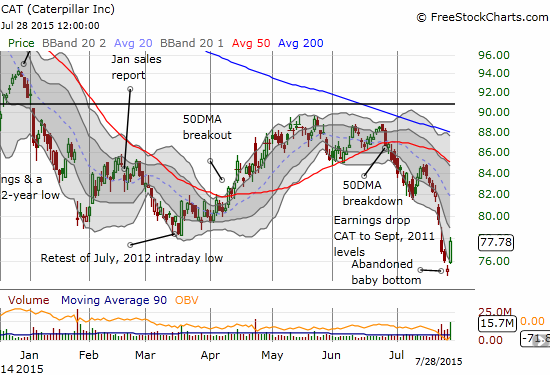
GrubHub (GRUB) had a chaotic day of post-earnings trading. The previous day, a downgrade instantly knocked the stock down to retest of all-time lows. Traders and investors naturally feared that the downgrade indicated GRUB had very bad news in store. Instead, GRUB produced pedestrian numbers, far from alarming. The resulting gap up rammed the stock right into resistance at the 50DMA. Sellers went to work immediately from there. It took me a while to understand what could be going on. And then I saw that a conference call was coming at 10am Eastern. So, essentially, whoever did not get a chance to panic and sell the day before was scrambling to use the post-earnings gap up to get out ahead of what HAD to be the real bad news. The stock made a fresh all-time low just ahead of the conference call. The stock bounced from there and chopped away to a net 7.2% gain on the day.
This action was a lesson in the dangers of panic. For me, it was a lesson in patience as I rushed in to buy into today’s panic. The subsequent bounce did allow me to get out with a gain, but I would have performed a LOT better by simply waiting for some (ANY!) sign of buying interest.
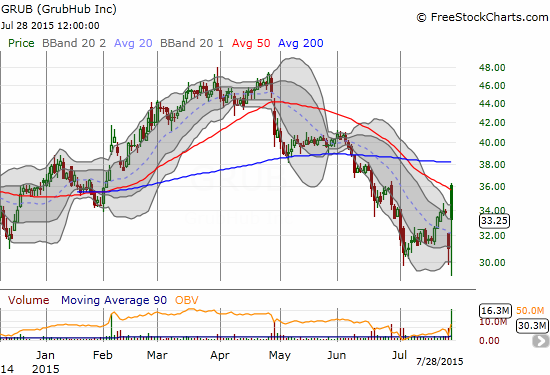
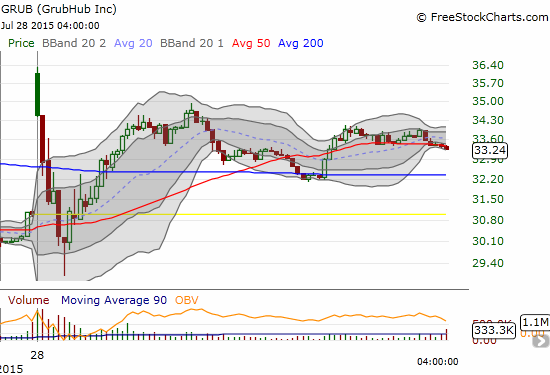
After all the pre and post-earnings angst, Apple (AAPL) is simply trading at the lower end of an on-going trading range. The 50DMA remains the presumed pivot within this trading range. I missed the nice surge off post-earnings lows. I am looking for another bounce off the bottom of the trading range. (I know I still owe you readers an update on all the pre/post-earnings data on AAPL!)
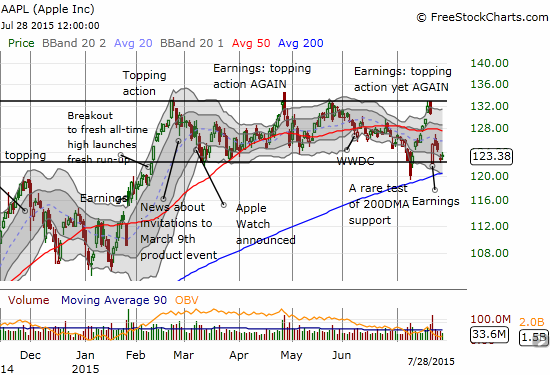
Among today’s scans from the SwingTradeBot is this one…
Scan results – Gilligan’s Island Buy Setup today: $CVLT $BIDU $RDWR $CKEC $CIT $AHL $TMK … http://t.co/9SVAbD2R1T
— SwingTradeBot (@SwingTradeBot) July 28, 2015
My eyes once again lit up. I know I said in “The Only Remaining China-Based Trade I Like” that I am going to leave Baidu (BIDU) alone even with its tendency to bounce sharply from steep sell-offs. Given my experience with CAT, I am likely going to make an exception this time if BIDU meets the “Gilligan” criteria tomorrow. Stay tuned…!
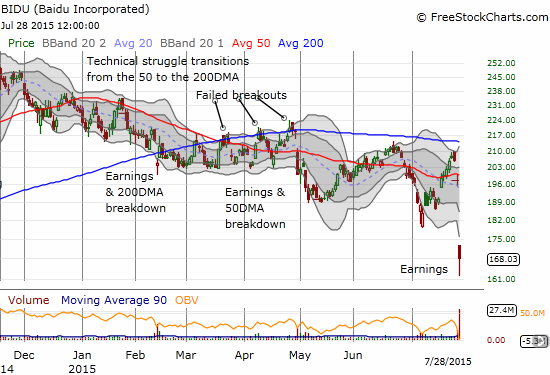
Daily T2108 vs the S&P 500

Black line: T2108 (measured on the right); Green line: S&P 500 (for comparative purposes)
Red line: T2108 Overbought (70%); Blue line: T2108 Oversold (20%)
Weekly T2108

*All charts created using freestockcharts.com unless otherwise stated
The charts above are the my LATEST updates independent of the date of this given T2108 post. For my latest T2108 post click here.
Related links:
The T2108 Resource Page
Expanded daily chart of T2108 versus the S&P 500
Expanded weekly chart of T2108
Be careful out there!
Full disclosure: short AUD/JPY, long AAPL call options
